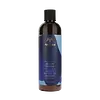What's inside
What's inside
 Key Ingredients
Key Ingredients

 Benefits
Benefits

 Concerns
Concerns

 Ingredients Side-by-side
Ingredients Side-by-side

Water
Skin ConditioningSodium Lauroyl Methyl Isethionate
CleansingCocamidopropyl Betaine
CleansingDisodium Laureth Sulfosuccinate
CleansingSodium Lauryl Sulfoacetate
CleansingGlycol Distearate
EmollientGlycerin
HumectantPiroctone Olamine
PreservativeAloe Barbadensis Leaf Extract
EmollientButylene Glycol
HumectantDextran
Trifolium Pratense Flower Extract
AstringentGuar Hydroxypropyltrimonium Chloride
Skin ConditioningPEG-150 Pentaerythrityl Tetrastearate
EmulsifyingPPG-2 Hydroxyethyl Cocamide
EmulsifyingDehydroacetic Acid
PreservativeBenzoic Acid
MaskingSodium PCA
HumectantLactic Acid
BufferingCitric Acid
BufferingSodium Benzoate
MaskingPotassium Sorbate
PreservativeAcetyl Tetrapeptide-3
Skin ProtectingPhenoxyethanol
PreservativeParfum
MaskingWater, Sodium Lauroyl Methyl Isethionate, Cocamidopropyl Betaine, Disodium Laureth Sulfosuccinate, Sodium Lauryl Sulfoacetate, Glycol Distearate, Glycerin, Piroctone Olamine, Aloe Barbadensis Leaf Extract, Butylene Glycol, Dextran, Trifolium Pratense Flower Extract, Guar Hydroxypropyltrimonium Chloride, PEG-150 Pentaerythrityl Tetrastearate, PPG-2 Hydroxyethyl Cocamide, Dehydroacetic Acid, Benzoic Acid, Sodium PCA, Lactic Acid, Citric Acid, Sodium Benzoate, Potassium Sorbate, Acetyl Tetrapeptide-3, Phenoxyethanol, Parfum
Water
Skin ConditioningLauramidopropyl Hydroxysultaine
CleansingSodium Cocoyl Isethionate
CleansingCocamide Mipa
EmulsifyingBetaine
HumectantRicinus Communis Seed Oil
MaskingSodium Isethionate
CleansingCetearyl Alcohol
EmollientSodium Chloride
MaskingPiroctone Olamine
PreservativeCeramide NP
Skin ConditioningCeramide EOP
Skin ConditioningCeramide AP
Skin ConditioningPhytosphingosine
Skin ConditioningZanthoxylum Bungeanum Pericarp Extract
Skin ConditioningPhytosterols
Skin ConditioningHydroxypropyl Bislauramide Mea
EmollientHydroxypropyl Bisstearamide Mea
Skin ConditioningMentha Piperita Oil
MaskingMelaleuca Alternifolia Leaf Oil
AntioxidantMenthol
MaskingOlea Europaea Fruit Oil
MaskingPolyglyceryl-10 Laurate
Skin ConditioningGlycol Stearate
EmollientGlyceryl Stearate
EmollientSodium Lauroyl Lactylate
EmulsifyingSodium Cocoyl Glutamate
CleansingCoconut Acid
CleansingGlycerin
HumectantPolyquaternium-7
Stearic Acid
CleansingTrisodium Dicarboxymethyl Alaninate
Hydroxypropyl Cyclodextrin
MaskingCaprylyl Glycol
EmollientEthylhexylglycerin
Skin ConditioningSodium Benzoate
MaskingPotassium Sorbate
PreservativeCitric Acid
BufferingLimonene
PerfumingWater, Lauramidopropyl Hydroxysultaine, Sodium Cocoyl Isethionate, Cocamide Mipa, Betaine, Ricinus Communis Seed Oil, Sodium Isethionate, Cetearyl Alcohol, Sodium Chloride, Piroctone Olamine, Ceramide NP, Ceramide EOP, Ceramide AP, Phytosphingosine, Zanthoxylum Bungeanum Pericarp Extract, Phytosterols, Hydroxypropyl Bislauramide Mea, Hydroxypropyl Bisstearamide Mea, Mentha Piperita Oil, Melaleuca Alternifolia Leaf Oil, Menthol, Olea Europaea Fruit Oil, Polyglyceryl-10 Laurate, Glycol Stearate, Glyceryl Stearate, Sodium Lauroyl Lactylate, Sodium Cocoyl Glutamate, Coconut Acid, Glycerin, Polyquaternium-7, Stearic Acid, Trisodium Dicarboxymethyl Alaninate, Hydroxypropyl Cyclodextrin, Caprylyl Glycol, Ethylhexylglycerin, Sodium Benzoate, Potassium Sorbate, Citric Acid, Limonene
Ingredients Explained
These ingredients are found in both products.
Ingredients higher up in an ingredient list are typically present in a larger amount.
Citric Acid is an alpha hydroxy acid (AHA) naturally found in citrus fruits like oranges, lemons, and limes.
Like other AHAs, citric acid can exfoliate skin by breaking down the bonds that hold dead skin cells together. This helps reveal smoother and brighter skin underneath.
However, this exfoliating effect only happens at high concentrations (20%) which can be hard to find in cosmetic products.
Due to this, citric acid is usually included in small amounts as a pH adjuster. This helps keep products slightly more acidic and compatible with skin's natural pH.
In skincare formulas, citric acid can:
While it can provide some skin benefits, research shows lactic acid and glycolic acid are generally more effective and less irritating exfoliants.
Most citric acid used in skincare today is made by fermenting sugars (usually from molasses). This synthetic version is identical to the natural citrus form but easier to stabilize and use in formulations.
Read more about some other popular AHA's here:
Learn more about Citric AcidGlycerin is already naturally found in your skin. It helps moisturize and protect your skin.
A study from 2016 found glycerin to be more effective as a humectant than AHAs and hyaluronic acid.
As a humectant, it helps the skin stay hydrated by pulling moisture to your skin. The low molecular weight of glycerin allows it to pull moisture into the deeper layers of your skin.
Hydrated skin improves your skin barrier; Your skin barrier helps protect against irritants and bacteria.
Glycerin has also been found to have antimicrobial and antiviral properties. Due to these properties, glycerin is often used in wound and burn treatments.
In cosmetics, glycerin is usually derived from plants such as soybean or palm. However, it can also be sourced from animals, such as tallow or animal fat.
This ingredient is organic, colorless, odorless, and non-toxic.
Glycerin is the name for this ingredient in American English. British English uses Glycerol/Glycerine.
Learn more about GlycerinPiroctone Olamine is used to treat fungal infections and often found in anti-dandruff shampoo.
This ingredient is particularly effective against Malassezia, the root cause of dandruff.
Piroctone olamine is water-soluble.
Learn more about Piroctone OlaminePotassium Sorbate is a preservative used to prevent yeast and mold in products. It is commonly found in both cosmetic and food products.
This ingredient comes from potassium salt derived from sorbic acid. Sorbic acid is a natural antibiotic and effective against fungus.
Both potassium sorbate and sorbic acid can be found in baked goods, cheeses, dried meats, dried fruit, ice cream, pickles, wine, yogurt, and more.
You'll often find this ingredient used with other preservatives.
Learn more about Potassium SorbateSodium Benzoate is a preservative. It's used in both cosmetic and food products to inhibit the growth of mold and bacteria. It is typically produced synthetically.
Both the US FDA and EU Health Committee have approved the use of sodium benzoate. In the US, levels of 0.1% (of the total product) are allowed.
Sodium benzoate works as a preservative by inhibiting the growth of bacteria inside of cells. It prevents the cell from fermenting a type of sugar using an enzyme called phosphofructokinase.
It is the salt of benzoic acid. Foods containing sodium benzoate include soda, salad dressings, condiments, fruit juices, wines, and snack foods.
Studies for using ascorbic acid and sodium benzoate in cosmetics are lacking, especially in skincare routines with multiple steps.
We always recommend speaking with a professional, such as a dermatologist, if you have any concerns.
Learn more about Sodium BenzoateWater. It's the most common cosmetic ingredient of all. You'll usually see it at the top of ingredient lists, meaning that it makes up the largest part of the product.
So why is it so popular? Water most often acts as a solvent - this means that it helps dissolve other ingredients into the formulation.
You'll also recognize water as that liquid we all need to stay alive. If you see this, drink a glass of water. Stay hydrated!
Learn more about Water